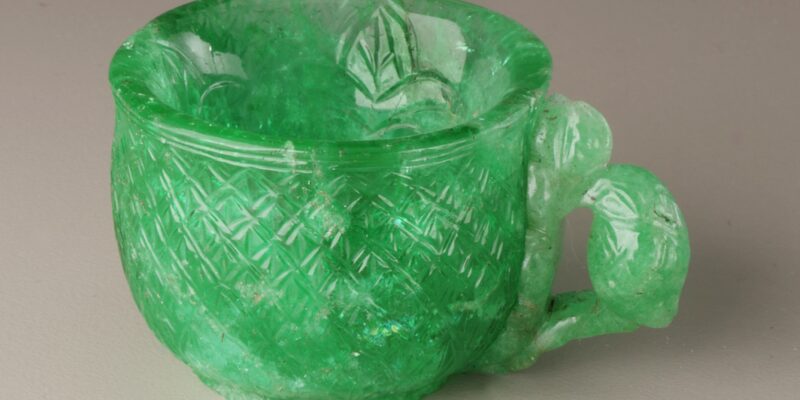
May ~ Month of Emerald
Leave your thoughtsHistory

Source: Smithsonian
Emerald, a symbol of rebirth, is believed to grant the owner foresight, good fortune, and youth. Emerald, derived from the word “smaragdus,” means, quite literally, “green” in Greek.
Rome’s Pliny the Elder described emerald in his Natural History, published in 1st century AD. He described early lapidaries, who “have no better method of restoring their eyes than by looking at the emerald, its soft, green color comforting and removing their weariness and lassitude.” Even today, the color green is known to relieve stress and eye strain.
The first known emerald mines were in Egypt, dating from at least 330 BC into the 1700s. Cleopatra was known to have a passion for emerald, and used it in her royal adornments. She even claimed ownership of all emerald mines in Egypt during her reign.

Source: Smithsonian, Photo by Chip Clark
Pre-16th century, the Incas used emeralds in religious ceremonies. When Spanish explorers invaded the New World, they plundered emeralds from what is now Columbia, then traded them for precious metals. The Muzo Indians’ mines were so well hidden, it took the conquistadors nearly twenty years to find them. As trade extended to other parts of the world, European and Asian royalty to began to take an interest in emeralds.
This 75.47-carat Emerald was first worn by Ottoman Sultan Abdul Hamid II, the last sultan of the Ottoman Empire, in his belt buckle. Tiffany purchased the stone in 1911 and made the brooch in 1950. Mrs. Janet Annenberg Hooker bought it in 1955 and eventually donated it to the Smithsonian.
Emerald Gemstone Sources

Source: Smithsonian

Colombia has been the source of the finest emeralds for more than 500 years, and Colombian emeralds are the standard by which all others are measured. Three mining sites in Colombia are particularly noteworthy: Muzo (darker tones of pure green), Chivor (lighter in tone and slightly bluish green) and Coscuez (slightly yellowish green). The May birthstone is also found in the state of Minas Gerais, Brazil; Zambia, Africa; Pakistan; and Afghanistan.
The deeper or more green an emerald is, the more valuable it is. The rarest emerald gemstones will appear to be an intense green-blue color.
More recently, a rare type of emerald has been gaining attention. These emeralds get their name from the trapiche (pronounced tra·PEE·che), a grinding wheel used in Colombia, South America to process sugarcane. Some of these gems resemble a spoked wheel with a hexagonal core. Trapiche emeralds can also be found in Brazil and Madagscar.
Some Famous Emeralds

Bulgari Emeralds
Today, emerald is a symbol of loyalty, new beginnings, peace, and security. They have always been a favorite among celebrities and royalty. Elizabeth Taylor owned a suite designed by Roman jeweler Bulgari. With her passing in 2011, the emeralds were sold at Christie’s in a legendary auction that raised $137.2 million for her AIDS foundation. These exquisite gems continue to sparkle in the Bulgari Heritage Collection as a reminder of her timeless elegance, love, and legacy in the world of cinema.
Please visit the GIA website to see the Crown of the Andes.

Source: Smithsonian
Please visit the Smithsonian Collection for more famous Emerald creations like these featured below:
After emigrating to New York in 1850, Hermann Marcus became an associate at Tiffany & Co. In the 1890s, he left Tiffany to help his two sons build what would become Marcus & Co., a highly respected American jewelry house. In the early 20th century, Marcus & Co. produced a variety of Revivalist-style jewelry including Egyptian and Mughal (Indian) inspired pieces like this brooch. Cabochon emeralds were a design element of historic Mughal jewelry and the Renaissance.

Source: Smithsonian
This Columbian emerald necklace was donated to the Smithsonian Institution by Mrs. Marjorie Merriweather Post, heir to the Post cereal fortune. Made by Cartier in 1928-1929, it’s Art Deco Indian-style features 24 baroque emerald drops. In this style, emeralds were often polished instead of faceted and drilled through to be used as beads.

Source: Smithsonian
According to legend, this emerald was once the centerpiece of an emerald and diamond necklace belonging to a Maharani of the former state of Baroda, India. It originally weighed 38.4 carats, but was recut and set in a platinum and gold ring designed by Harry Winston, Inc., where it is surrounded by 60 pear-shaped diamonds totaling 15 carats. It was donated to the Smithsonian by Mr. and Mrs. O. Roy Chalk. The gemstone, one of many Muzo, Colombian emeralds shipped to Mughal India by the Spanish in the 16th and 17th centuries, is a rectangular step-cut and now weighs 37.82 carats (7.564 g).
Maintenance
Emerald is a 7.5 to 8 on the Mohs scale of hardness, so it is more susceptible to scratching than a diamond, which ranks 10 on the scale. The availability of high-quality emerald is limited; consequently, treatments to improve clarity are performed regularly, e.g., dyeing and fracture.
Avoid exposure to heat, changes in air pressure (such as in an airline cabin) and harsh chemicals. Never put emerald in an ultrasonic cleaner, as the vibrations and heat can cause the filler to sweat out of fractures. Filled emeralds can also be damaged by exposure to hot water used for washing dishes. The safest way to clean emeralds is to gently scrub them with a soft brush and warm, soapy water.
Emerald is also the gemstone for twentieth and thirty-fifth wedding anniversaries.
Please visit the SFJS showroom to see our collection of emerald stones and beads. We also carry a variety of findings that are perfect for creating custom jewelry for that special someone!

